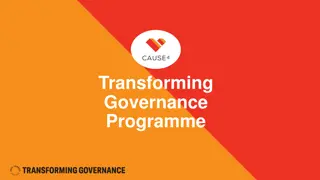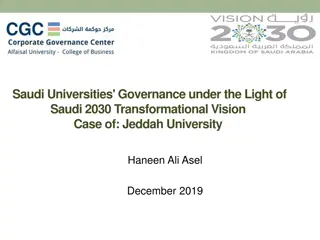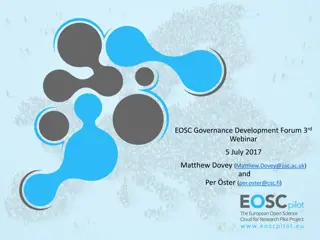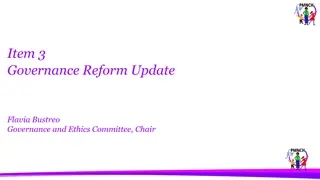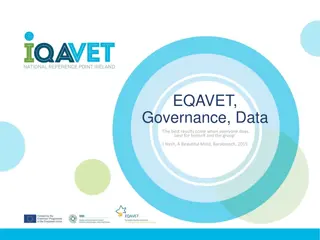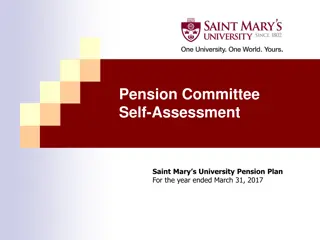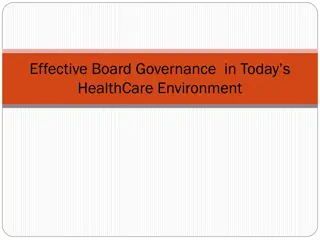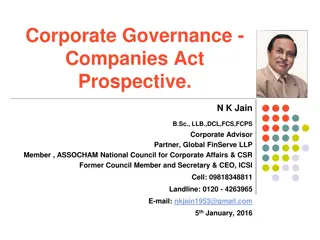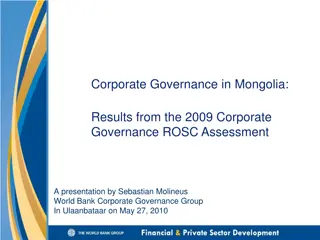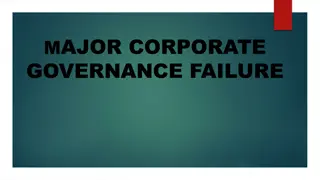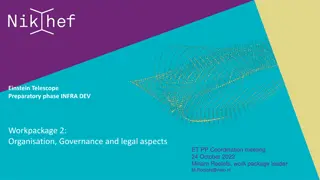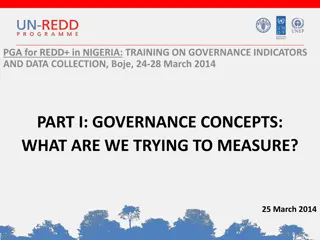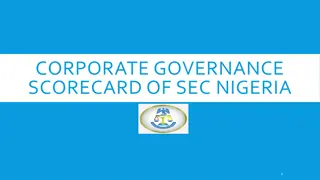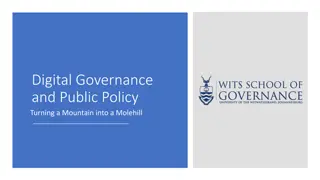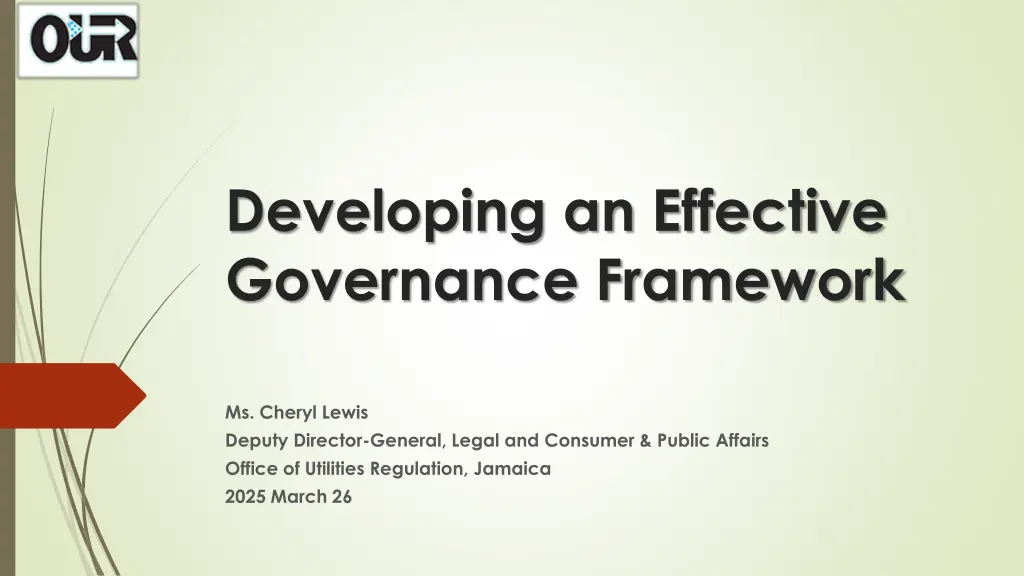
Developing an Effective Governance Framework for Regulators
Learn about the importance of regulators in ensuring access to quality public utilities, challenges with internal governance, corporate governance principles, and the impact of a good governance framework on regulatory effectiveness and integrity.
Download Presentation

Please find below an Image/Link to download the presentation.
The content on the website is provided AS IS for your information and personal use only. It may not be sold, licensed, or shared on other websites without obtaining consent from the author. If you encounter any issues during the download, it is possible that the publisher has removed the file from their server.
You are allowed to download the files provided on this website for personal or commercial use, subject to the condition that they are used lawfully. All files are the property of their respective owners.
The content on the website is provided AS IS for your information and personal use only. It may not be sold, licensed, or shared on other websites without obtaining consent from the author.
E N D
Presentation Transcript
Developing an Effective Governance Framework Ms. Cheryl Lewis Deputy Director-General, Legal and Consumer & Public Affairs Office of Utilities Regulation, Jamaica 2025 March 26
Regulators ensure access to and quality of public utilities, facilitate infrastructure investment, ensure the reliability of vital infrastructure, and protect market neutrality. Regulators are pivotal in making regulatory regimes work for sustainable growth and equitable societies. Regulators create the environment for investments Regulatory Environment Institutional forms of a regulator Minister/Government Department/a unit within a ministry Semi-Independent specialist utility: Company Self- Regulation Independent Regulator: a separate entity with its own statutory foundation, governing body, staff, and executive management.
Challenges with Internal Governance Do regulatory authorities document systematic processes? Do regulatory authorities have sufficient organizational checks and balances to meet their objectives? Are the objectives of the regulatory authority or stakeholders (Government) and the management aligned? What kind of supervisory mechanisms exist to make a suitable course correction in time? Issues
What is Corporate Governance? Governance which means helmsman or captain of the ship. One principally responsible for the direction and control of the organization System of rules, relationships, and practices that determine the direction and control of an organization OECD a key element in improving economic efficiency and growth as well as enhancing investor confidence . Good Governance Practice: 4 Pillars Transparency Accountability Stewardship Integrity
Impact of a Good Governance Framework A link between principles of good regulation and good governance Transparency and effectiveness in operational performance A direct link between corporate governance and efficiency Strengthen oversight processes and practices Consistency and predictable Links governance structures with good and bad financial performance of entities Strengthen the legitimacy and integrity of the Regulator
External and Internal Governance External governance (looking out from the regulator), focusing on the roles, relationships and distribution of powers and responsibilities between the legislature, the minister, the ministry, and Internal governance (looking into the regulator), focusing on the regulator s organisational structures, standards of behaviour and role and responsibilities, compliance and accountability measures, oversight of business processes, financial reporting, and performance management (OECD, 2014).
Building Blocks For Governance Architecture
Building Blocks For Governance Architecture
Building Blocks for Governance Architecture
Board & Managerial commitment Difficult to develop effective accountability frameworks and coordination mechanisms without strong commitment of Top Management. Top Management in this case, refers to Principal Officer, Board, and Management Top Management Commitment Management commitment is essential to ensure cultural acceptance of accountability and transparency throughout the organization and make systems (co- ordination arrangements) work in practice. Poor implementation Detrimental to good corporate governance
Governance Architecture Robust and reliable system for making confident and timely decisions Well crafted and appropriately implemented Clarity on the respective roles of ministries and Government appropriate balance between the independence of the regulator and its accountability Not one size fits all
Board Composition, Functions & Structure Board Composition Independent Members, non-executive members, no of executive members? Are the roles of the Minister or Chairman clear? Who oversees the strategic policy direction of the regulatory agency/unit? Does the composition of the Board reflect the competencies identified for effective regulation? Is there a formal process of director induction, orientation, and training? Do Board members participate in training on Corporate Governance? Are there Committees that assist in the decision-making? Periodic review or evaluation of the Board s overall performance? How often does the Board meet?
Corporate Governance Policies, Procedures & Practices Approved Board Charter (Direction, Management & Control) A written policy document that defines the scope, role, responsibilities, and processes of a company's board of directors, both individually and collectively, ensuring good governance and ethical decision-making. Conde of Conduct and Business Ethics Board Meetings Notification, documentation provided Documentation of Deliberations (Minutes/Notes) Executive and senior Managers training in Corporate Governance Are performance standards set and how are they set and by whom? Is the CEO/ Principal Officer appraised annually Is the Performance of senior management appraised at least annually?
Compliance and Disclosure of Information Corporate Plan Monthly/quarterly Reports Annual Reports How is information revealed to stakeholders: Updated Website; Media Releases, Financial Statements, Annual Reports Disclosure of Conflict of Interest/ related third party transactions at board meetings Protected Disclosures (Whistleblowing) policy of the organization
Risk Measurements & Internal Control Enterprise Risk Management (ERM) policy: a process that organizations use to identify, assess, and manage risks that could impact their ability to achieve their strategic goals, encompassing operational, strategic, and financial risks. System and procedures for risk identification, measurement, monitoring and control and the role of the Board in this process. Business Continuity and/Disaster recovery plan Corporate Risk Register Internal Control Policies Internal Audit function Internal Audit Charter defines the purpose, authority, and responsibility of the internal audit function within an organization, serving as a guide for its activities and a benchmark for its effectiveness.

